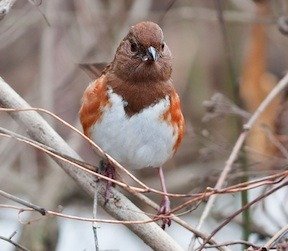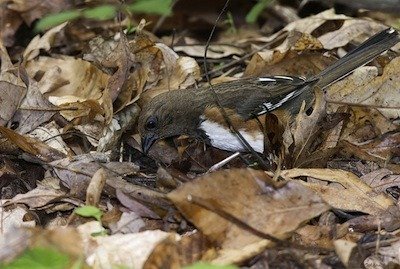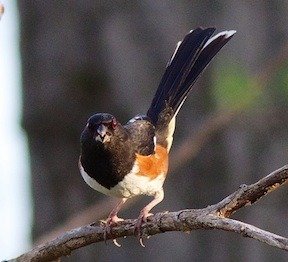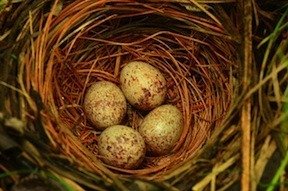





The striking coloring of the Eastern towhee makes it highly noticeable, should you be lucky enough to catch a glimpse of it. You're much more likely to hear it energetically foraging through undergrowth.This species searches out insects and seeds in leaf litter, using both of its big feet at once in a lively backwards hopping motion.
Appearance
Male Eastern towhees are handsomely marked, with inky black feathers above and on the breast, with warm rusty red sides and a white belly. Females are similar in coloring to the males, except with brown replacing the black.  Like all sparrows, the Eastern towhee has a thick, triangular beak, a chunky body and long tail. At about seven to eight inches long, this bird is smaller than a robin, but considerably larger than a song sparrow. Its flight is short and bounding.
Like all sparrows, the Eastern towhee has a thick, triangular beak, a chunky body and long tail. At about seven to eight inches long, this bird is smaller than a robin, but considerably larger than a song sparrow. Its flight is short and bounding.
Name
This bird’s scientific name, Pipilo erythophthalmus, means “red-eyed chirper”, a reference to both its red eyes and its lively song. In some places, the Eastern towhee is known as the “chewink” after its happy call. Not all Eastern towhees have red eyes -- individuals with straw-colored eyes can be found in some parts of Florida and the Southeast.
At one time, the Eastern towhee and the similar spotted towhee of the western U.S. were thought to be the same species, called the rufous-sided towhee. The two types can be found together in the Great Plains, where they sometimes interbreed to create a hybrid. The collective name for this bird is a “tangle” or “teapot” of towhees.
Habitat/Range
The Eastern towhee spends most of its time exploring leaf litter in undergrowth, thickets and brushy edges of open woods. This short-distant migrant inhabits all of the eastern U.S. Eastern towhees in northern states fly south for the winter, while those in the Southeast may reside there year-round.
Diet
Although the Eastern towhee’s diet varies according to the season, it feeds largely on insects, seeds and berries. Most of its foraging is done by scratching through leaves on the ground, although it also sometimes searches for food in shrubs and low trees.
Behavior
When a female Eastern towhee first enters a male’s territory, he may behave as if she’s an unwelcome visitor. He eventually not only tolerates her but begins following her everywhere as courtship ensues. A male towhee may defend his territory from other males by singing from a high perch, or by putting on a wing-fanning display that exposes his white tail corners.
Song
Besides the “chewink” call made by both sexes, the male Eastern towhee is known for delivering a bright “drink-your-teeea” song, ending with a musical trill. Listen to the Eastern towhee here.
Nesting Eastern towhees not only eat primarily on the ground, they also build nests there, in a thicket or low in a shrub or tangle of vines. After building an open cup-shaped nest of grass, twigs and other materials, the female lays three to four brown-speckled cream-colored eggs. Both parents feed the babies, who may remain near the nest even after achieving independence. Eastern towhee pairs frequently raise two broods per year, or even three in the southern reaches of their range.
Eastern towhees not only eat primarily on the ground, they also build nests there, in a thicket or low in a shrub or tangle of vines. After building an open cup-shaped nest of grass, twigs and other materials, the female lays three to four brown-speckled cream-colored eggs. Both parents feed the babies, who may remain near the nest even after achieving independence. Eastern towhee pairs frequently raise two broods per year, or even three in the southern reaches of their range.
Parasitic cowbirds often take advantage of Eastern towhee nests. They remove one or more eggs and replace them with their own, causing in the unsuspecting towhee parents to raise baby cowbirds.
How to Attract to Your Yard
If you wish to attract this pretty bird, allow some areas of your property to stay brushy and overgrown, strewn with plenty of leaf litter. Eastern towhees will visit feeders to eat fallen seed, particularly if a thicket is nearby. You may be able to coax them out of the brush by spreading cracked corn or sunflower seed on the ground.
More Information:
Audubon: Eastern Towhee
Cornell Lab of Ornithology: All About Birds -- Eastern Towhee
Bird Watchers Digest: Eastern Towhee
Photo Credits:
thumbnail and male towhee by Henry T. McLin
female towhee and towhee in underbrush by Kelly Cogan Azar
towhee nest by Joshua Mayer
Copyright © www.100flowers.win Botanic Garden All Rights Reserved